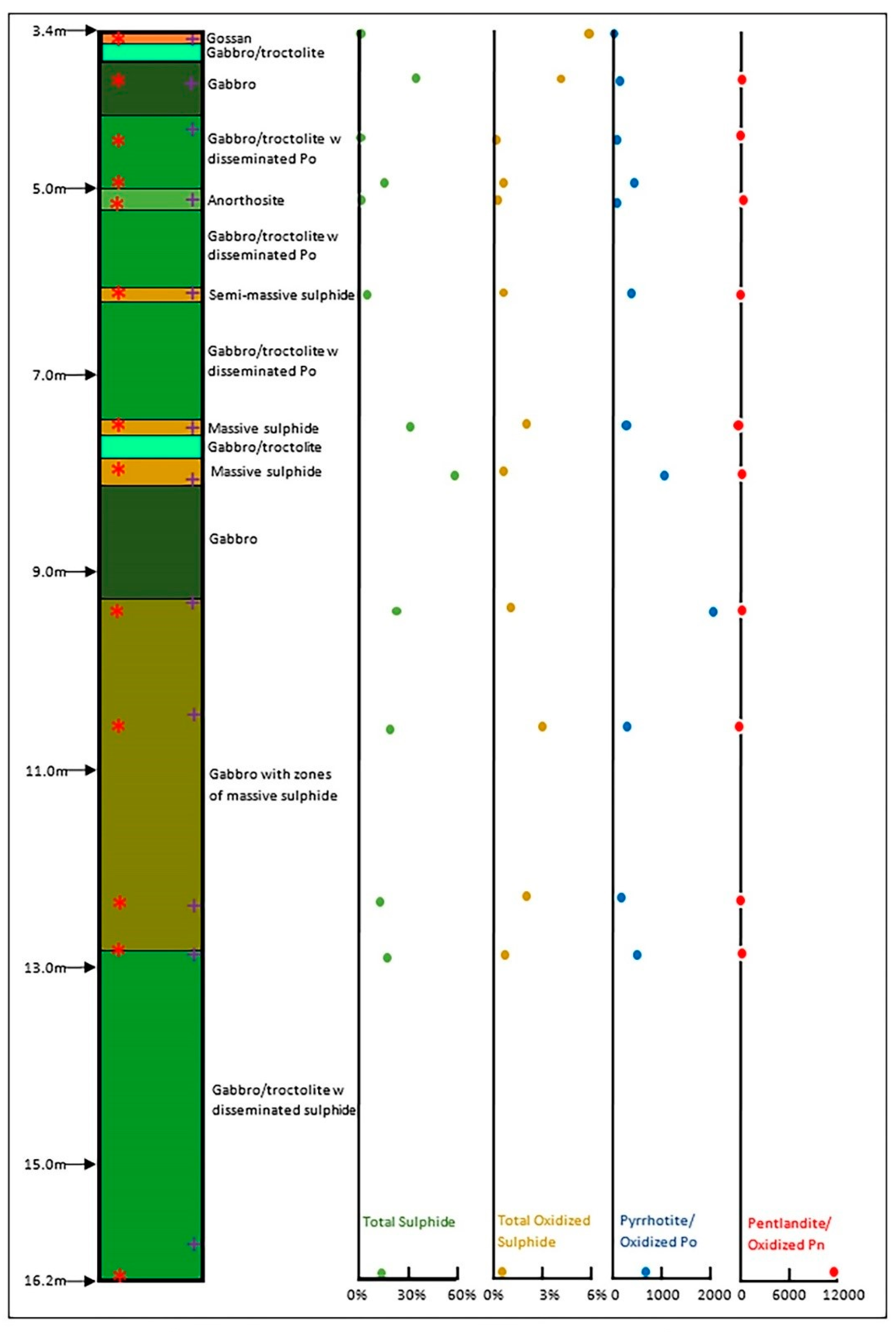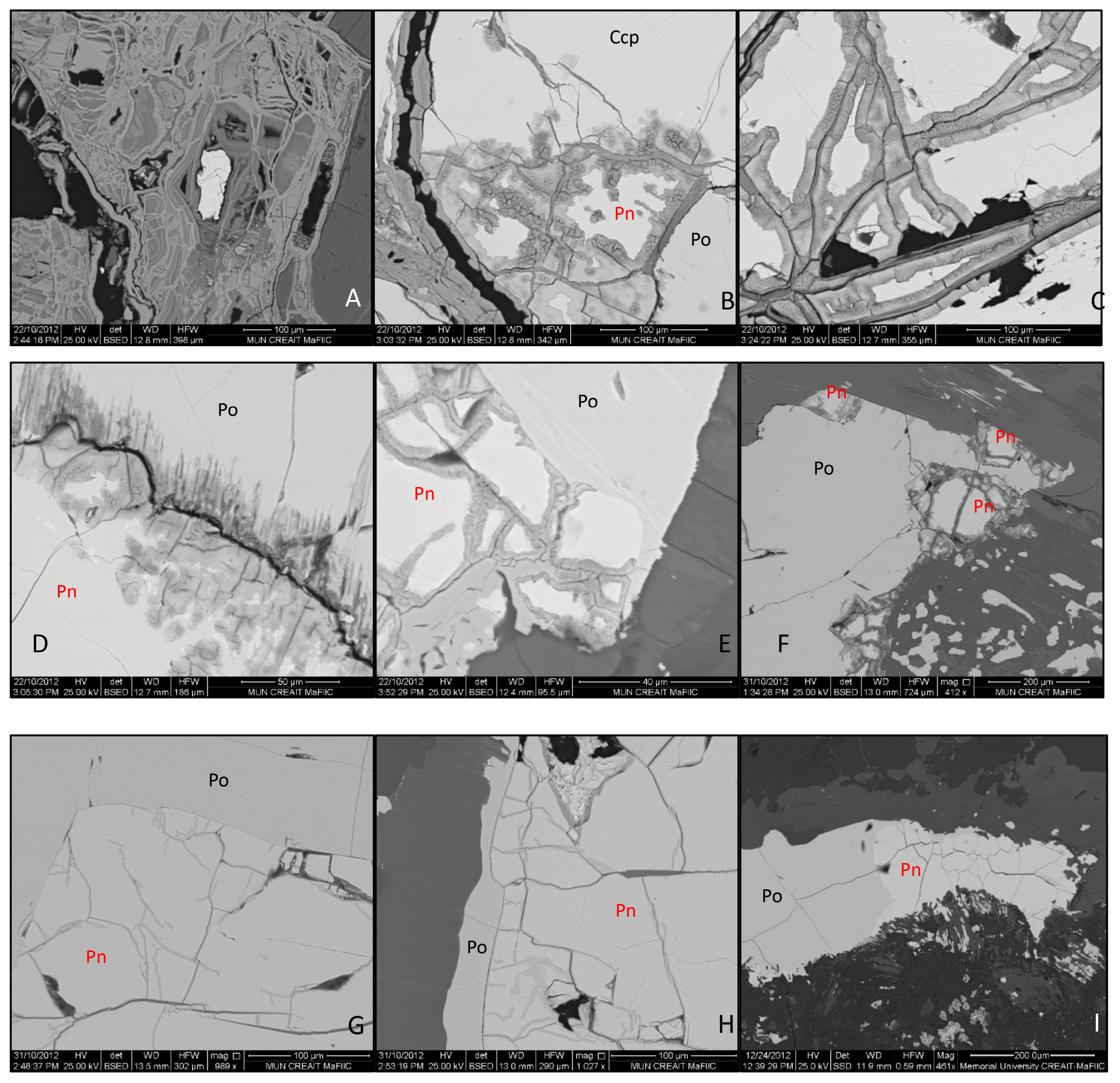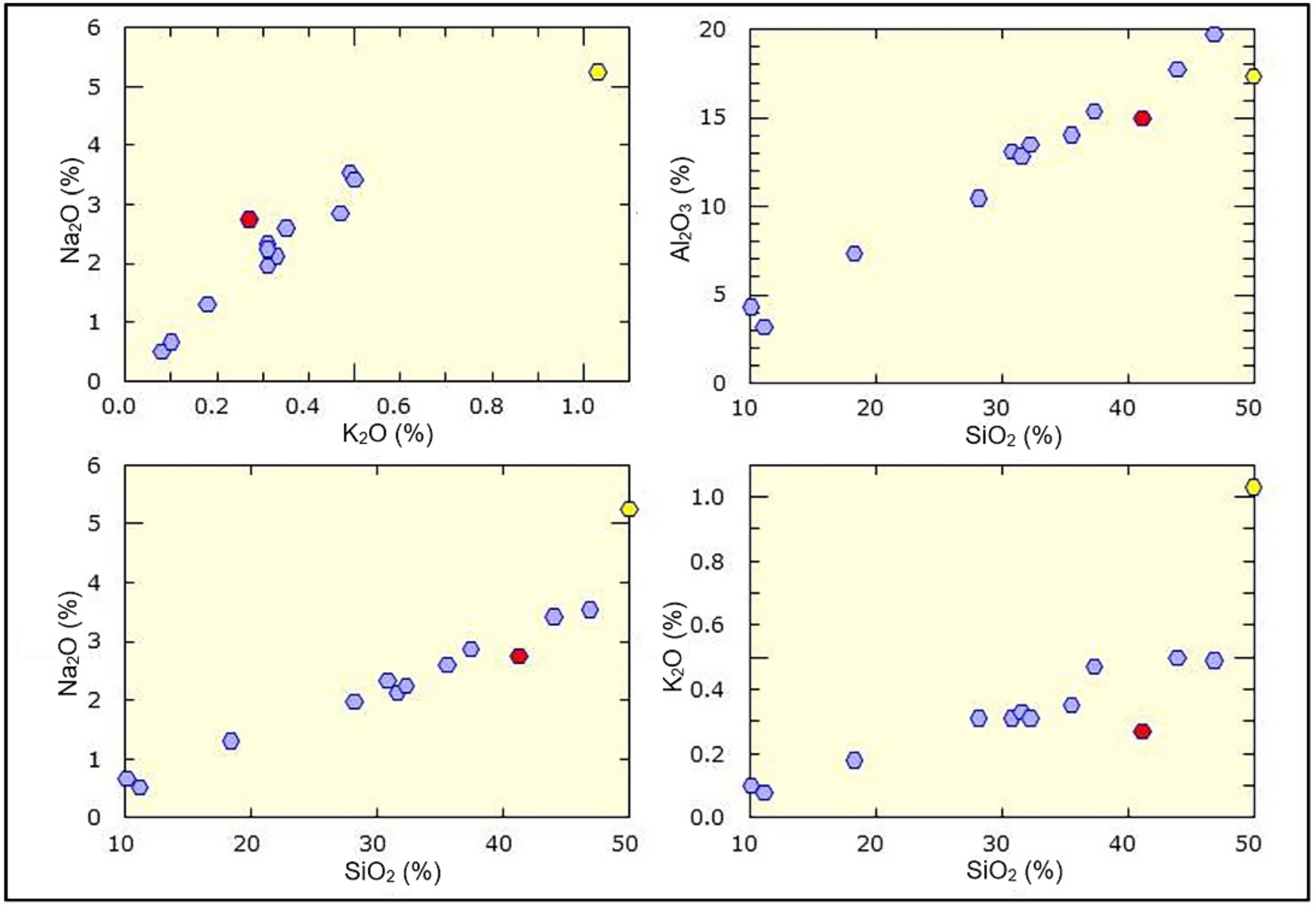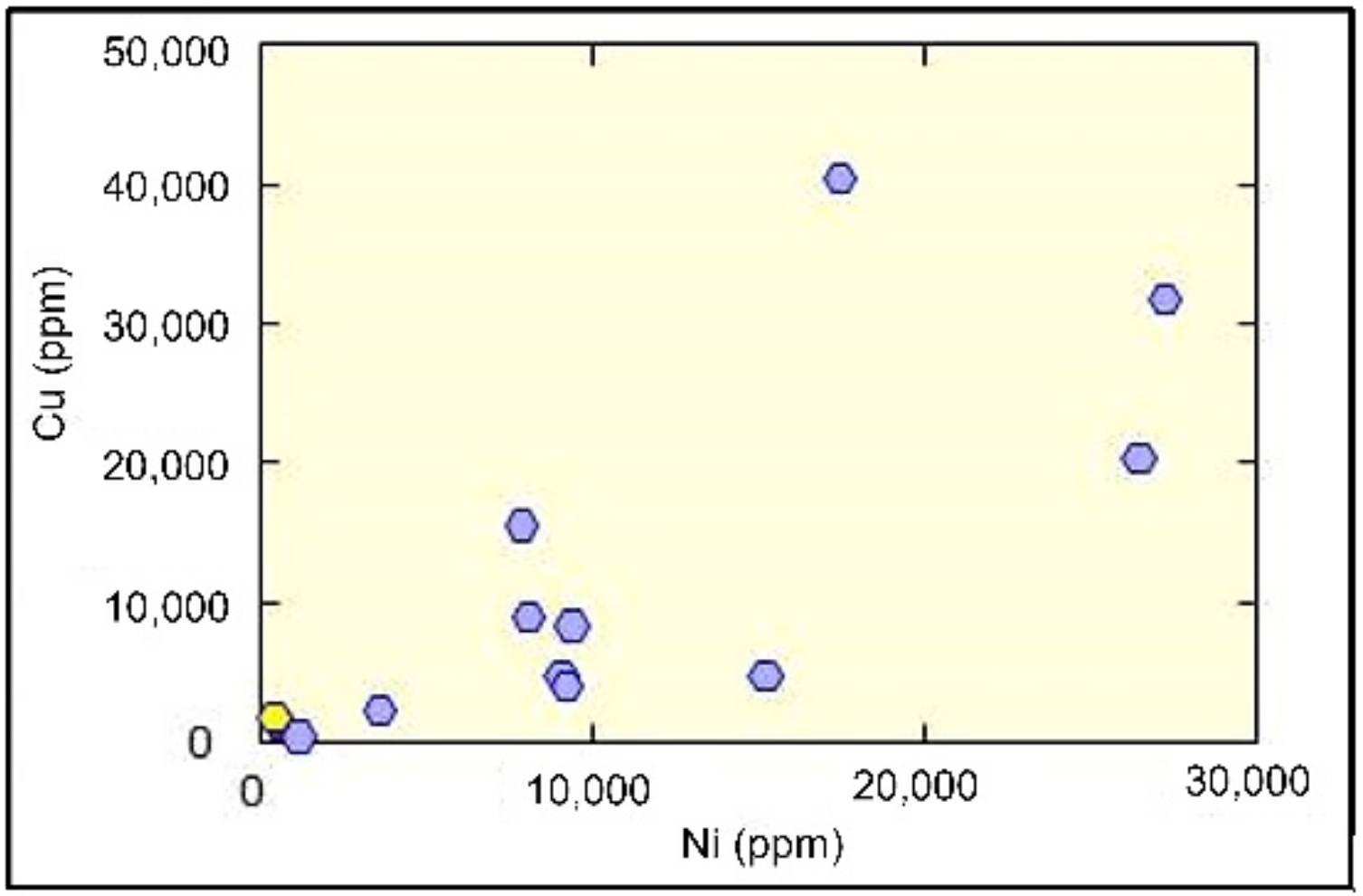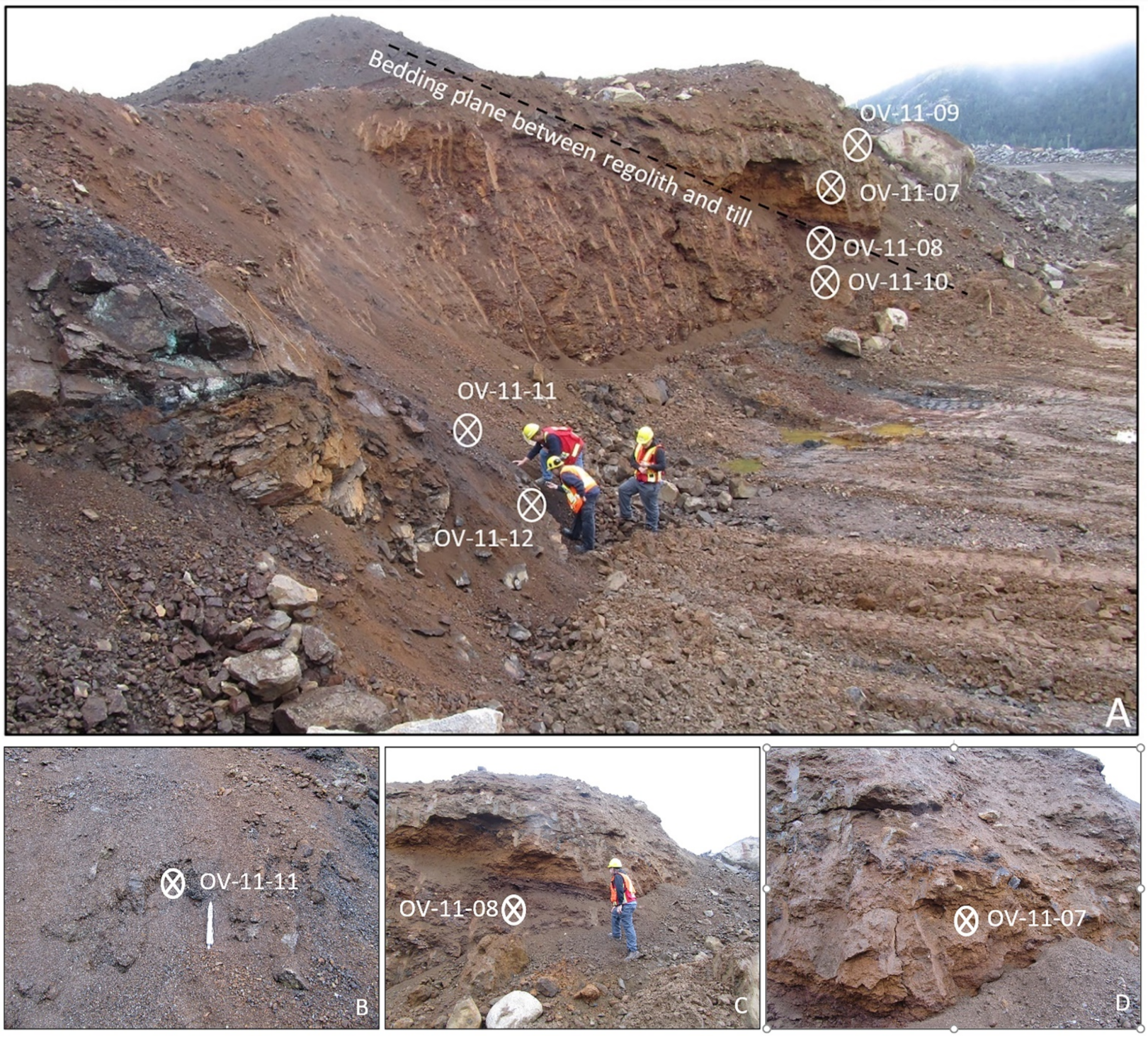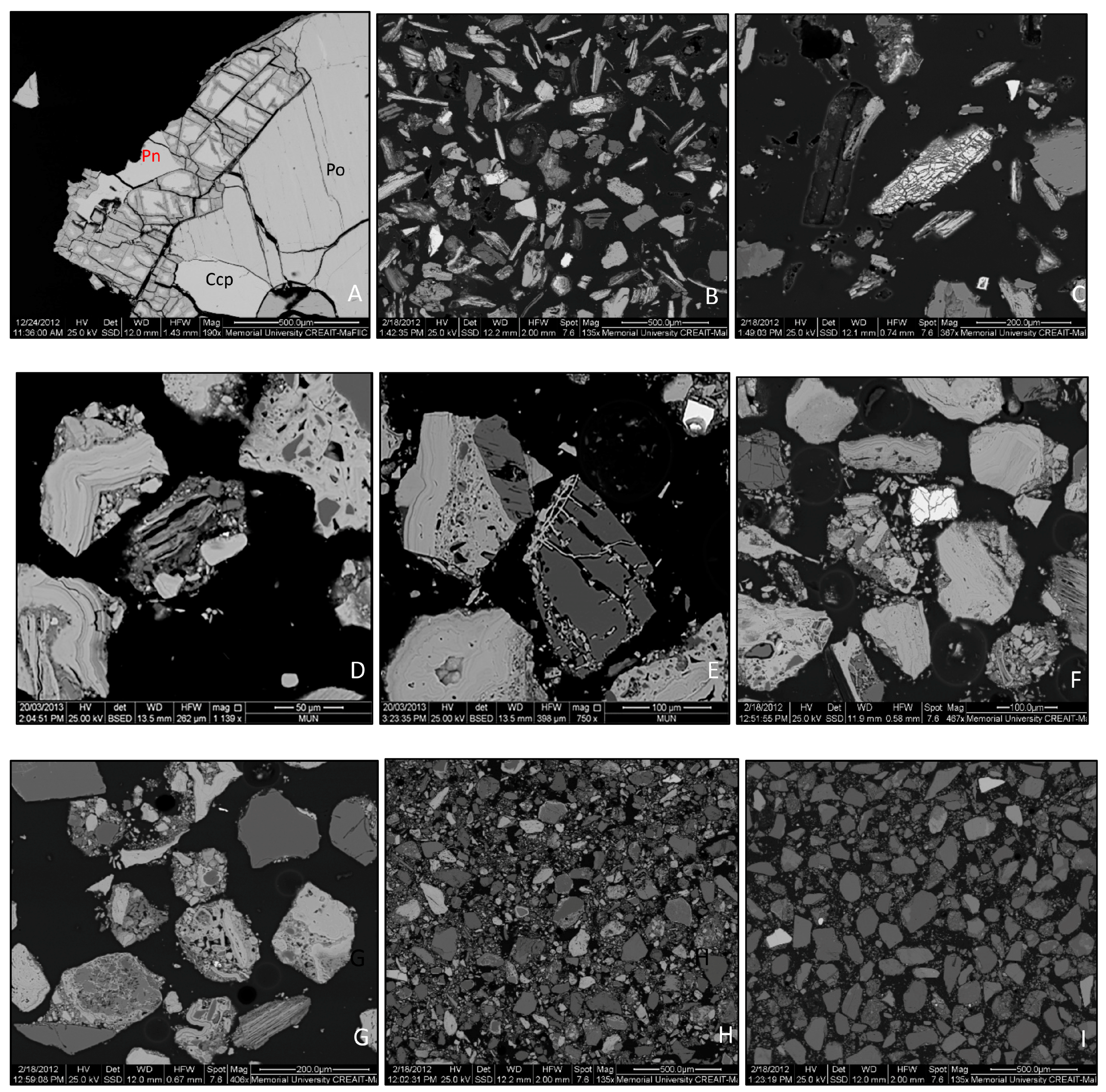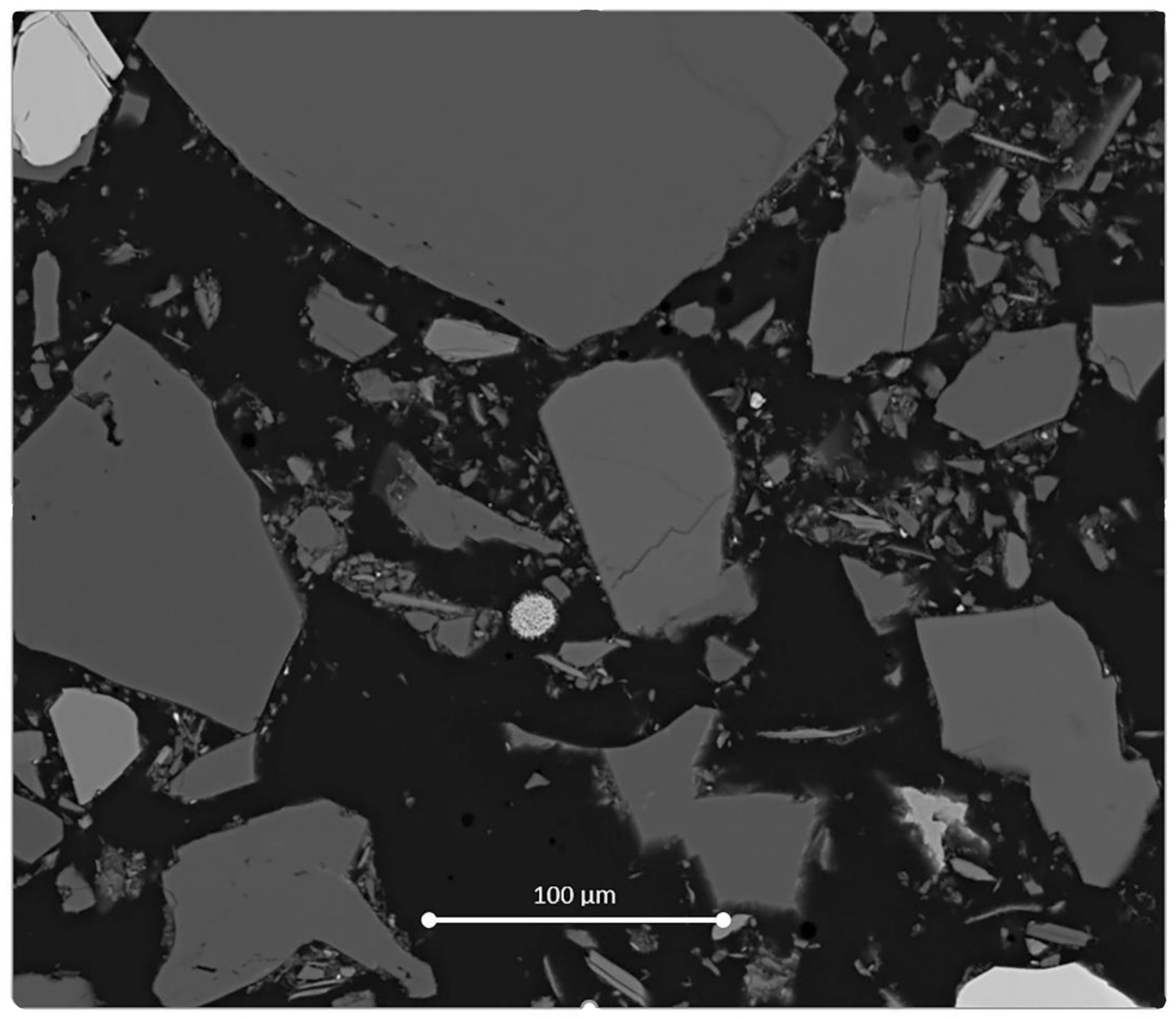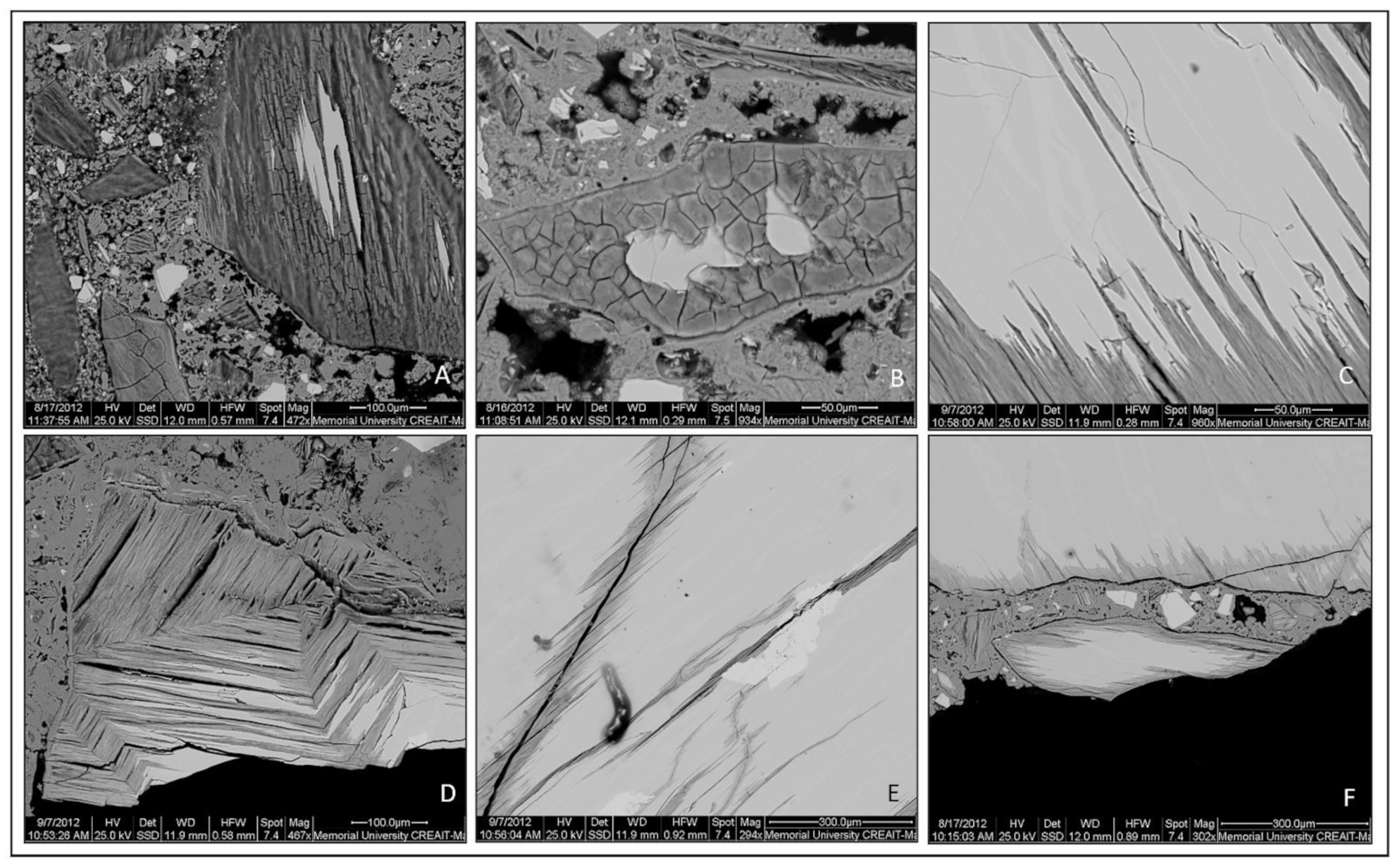1. Introduction
The Voisey’s Bay Ni-Cu-Co orthomagmatic sulphide deposits (
Figure 1) were discovered in 1993 when a small gossan (Discovery Hill) was sampled by prospectors [
1,
2,
3,
4,
5,
6,
7,
8]. The Ovoid deposit was discovered in a valley below Discovery Hill through geophysical surveys, buried beneath 10–20 m of glacial till [
9]. The Ovoid deposit consists of a bowl-shaped body of massive sulphide approximately 200–300 m in diameter [
3]. Geological models for the deposit suggest that it was much larger when it formed [
3], but the upper portion was essentially sliced off and removed by the last period of glaciation, ca. 10,000 to 18,000 years ago. When the surface of the Ovoid was exposed at the start of the mining operation it was found to be remarkably intact, with no alteration/oxidation whatsoever, as opposed to the Discovery Hill gossan.
The Voisey’s Bay Mine has been in production since 2005 as an open pit (Ovoid) with underground operations (Eastern Deeps and Reid Brook) commencing in 2021. The mine has evident and probable geological resources (2018) of 32.4 million tonnes of ore grading 2.13% Ni, 0.96% Cu, and 0.13% Co. Since 2005 the mine has produced concentrates in excess of 600 kt of nickel, 400 kt of copper, and 12 kt of cobalt from the sulphide ore with production expected to continue into at least 2033 [
10].
The following descriptions of the Voisey’s Bay deposit are based on [
1,
2,
3,
4,
5,
6,
7,
8,
9,
11]. The Voisey’s Bay mineralization consists of orthomagmatic sulphides hosted by troctolite feeder dykes of the Nain Plutonic Suite (NPS). The NPS is a large (ca., 19,000 km
2) intrusive suite that was emplaced along the ca. 1.85 Ga suture between the Churchill and Nain Provinces of the Canadian Shield. The predominant rock types in the NPS are anorthosite and granite, with lesser ferrodioritic/ferrogabbroic units and rare troctolite intrusions; the troctolites are early members of the NPS and have been dated to 1.34 Ga.
The Ovoid and Eastern Deeps deposits at Voisey’s Bay are hosted by the relatively rare, small troctolite intrusions. In the Reid Brook deposit, the mineralization was injected into paragneiss from troctolite magmatism. The sulphide ore bodies appear to have once been sulphide magmas associated with the troctolite magmas that flowed through the magma conduits. As such, the sulphide is collected in the feeder dykes or pooled at the base of magma chambers, as with the Ovoid and Eastern Deep deposits, respectively. Recent models suggest that the intrusion of the troctolite feeder dykes and sulphides was controlled by the E–W, trans-extensional, strike-slip fault zones with the sulphide collection and pooling related to dilatancies.
The sulphide mineralization styles vary within the Voisey’s Bay deposits from disseminated to semi-massive to massive and are dependent on the spatial distribution within the conduit. The Ovoid and Mini-Ovoid are the most robust ore bodies and are dominated by massive sulphides that may be enveloped by disseminated sulphides or contain disseminated sulphides intermittently along the footwall. The Reid Brook zone in the west is characterized by the disseminated to semi-massive sulphides. The sulphide mineralization within the Voisey’s Bay system is dominantly pyrrhotite, with 10% to 15% pentlandite and irregular chalcopyrite, cubanite, and magnetite concentrations.
The rationales of this research were: (1) to understand both how sulphides broke down and how they did not break down, potentially aiding in the development of strategies for the handling, transport, storage, re-analyses of legacy samples, and the ultimate disposal of sulphide material (i.e., ameliorating the environmental aspects of sulphide handling), and (2) to ascertain, which, if any, minerals, diagnostic of the sulphide mineralization, remained after sulphide destruction, and thus could be used to search for hidden (buried) sulphide deposits through the examination of glacial tills, and/or other erosional sediment media (i.e., a regional exploration tool in till/stream sediment surveys for the identification of buried mineralization).
There were six components to this project including: (1) a cross-section through the Discovery Hill gossan, as intersected in a diamond drill hole VB95-129; (2) the clay cover on the surface of the Ovoid massive sulphide body; (3) a section from the bedrock-hosted massive sulphide through “gossan” to the till in the Mini-Ovoid pit; (4) samples from five split spoon holes drilled around the Ovoid; (5) cuttings from a single sonic drill hole, northeast of the Ovoid mine; and (6) a group of coarse rejects from crushed drill core stored for over 10 years.
2. Materials and Methods
The MLA-SEM instrument used to examine the samples was a FEI Quanta 400 environmental Scanning Electron Microscope (SEM) equipped with a Bruker XFlash EDX Detector, in the CREAIT laboratories, Memorial University. The operating system used was FEI (2014) MLA Suite 3.1 Product Version 3.1.5.703. Data reduction programs used were MLA Image Processing and MLA Dataview. The SEM electron gun uses a tungsten filament at an operating voltage of 25 KV and a beam current of 10
3 nA. The working distance between sample and detector was 12 mm. Details on the instrument and systematics are described by [
12,
13,
14,
15].
The MLA detects mineral particles in a polished thin section or grain mount based on variations in back-scatter electron (BSE) grey scale, analysing each particle in turn. For the samples in this study, the greyscale “threshold” was set with the epoxy as black and metallic copper as white.
Fundamentally, a EDX (energy-dispersive) scanning electron (SEM) spectrum of each mineral grain mapped by the MLA was compared against a library of mineral spectra. For instance, in the case of pyrite and pyrrhotite, EDX spectra were collected from “standards” of each Fe-sulphide phase and stored in the library. Due to the large differences in EDX peak ratios of S to Fe in pyrite (2:1) vs. pyrrhotite (~1:1), the two minerals are readily distinguishable by the MLA software.
Samples examined in this study were a variety of surficial sediments, whole-rock drill core and bedrock, and crushed coarse rejects (
Figure 1). Whole-rock drill core samples were collected from drill hole VB95-129 through the Discovery Hill gossan and a bedrock sample was collected from the Mini-Ovoid Pit. Surficial sediment samples included clay cover on the Ovoid massive sulphide deposit, regolith and till samples from a transect of the pit wall at the Mini-Ovoid Pit, and till from split spoon core holes and a sonic drill hole. Coarse reject material from the Reid Brook deposit was recovered from lab storage.
Surficial sediment samples were mounted in epoxy pucks, polished, and coated in graphite prior to analysis by the SEM-MLA instrument. Polished thin sections of drill core and rock samples were prepared by Vancouver Petrographic and similarly graphite-coated prior to MLA-SEM analysis. Aside from the quantitative mineralogy generated by the MLA-SEM, high-quality Back Scatter Electron (BSE) photomicrographs were derived of constituent minerals and their intergrowths in post-processing mode. These proved to be invaluable in the examination of the alteration and weathering.
Whole-rock (VB95-129 drill core and Mini-Ovoid bedrock) and surficial sediment samples of regolith and till from the Mini-Ovoid pit wall were submitted to ALS Geochemistry, Vancouver, as part of the regular Vale NL Exploration sample stream. The samples were subjected to lithium borate fusion prior to acid digestion and analysis via ICP-MS (ALS package ME-MS81TM). The Vale Exploration protocol followed National Instrument 43-101 Quality Assurance and Quality Control reporting requirements with insertion of reference materials, banks, and duplicates along with the regular samples.
3. Results
3.1. Section through the Discovery Hill Gossan (Diamond Drill Hole VB95-129)
This portion of the study involved detailed MLA-SEM and whole-rock geochemical analyses of the diamond drill hole VB95-129 drilled in 1995. This hole was chosen as it was collared in, and cut through, a section of the Discovery Hill gossan. The hole was only drilled to a depth of 16.2 m and the complete hole was sent from the Voisey’s Bay site by Vale technicians to the CREAIT labs at Memorial University where it was prepared for MLA and a whole-rock geochemical analysis.
The hole was re-logged in a simple fashion (
Figure 2) and thirteen samples were removed from the core and prepared as polished thin section and another portion was crushed for a whole-rock geochemical analysis. Below the gossan, the hole intersected troctolite at 5.8 m with local semi-massive and disseminated sulphide intervals, anorthosite interlayers, and sulphide-bearing (massive and disseminated) anorthosite layers.
The mineral percentages mapped by the MLA are listed in
Table 1. Only samples from 3.9–3.97 m, 7.45–7.5 m, and 7.98–8.0 m constituted massive sulphide; the 3.4–3.5 m sample was massive sulphide but is now gossan. Aside from the VB95-129 massive sulphide samples, MLA mapping indicates that the most abundant minerals in the other samples were silicates and oxides (
Table 1). In the sample from 3.4–3.5 m, the gossan-dominant minerals are plagioclase (32%), limonite (28.4%) and clay minerals (10.35%). The oxidized sulphide component only accounted for 5.53% and sulphide was only 0.01%. In other samples downhole from the gossan, pyrrhotite was the most abundant sulphide and ubiquitous throughout the core with a modal abundance ranging from trace amounts up to 53.89%. Pentlandite was a significant mineral only in the samples from 3.9–3.97 m (2.9%), 4.96–4.98 m (1.27%), 7.98–8.0 m (2.99%), 9.35–9.40 m (2.48%), 12.88–12.90 m (1.89%) and 16.13–16.2 m (1.36%); oxidized pentlandite accounted for 2.21%, 1.87%, and 1.0% in the samples 3.90–3.97 m, 10.55–10.60 m, and 12.3–12.35 m, respectively. Chalcopyrite was only mapped by the MLA as a significant mineral in samples 3.9–3.97 m (3.53%), 7.45–7.5 m (1.2%), 7.95–8.0 m (2.12%), 12.30–12.35 m (1.48%), and 16.13–16.20 m (7.7%).
In terms of the other mineral phases identified by the MLA, there are variations in the contents of the silicate minerals between the samples that represent differences in the rock type (i.e., gabbro vs. troctolite vs. anorthosite). These minerals include plagioclase, clinopyroxene, biotite, and hornblende. For instance, the anorthosite sample (5.15–5.20 m) has greater albite, apatite, and biotite contents than the other samples; the gabbro (3.9–3.97 m) contains more clinopyroxene than the other samples; and the gabbro/troctolite sample from 16.13–16.2 m is significantly enriched with hornblende compared to the other samples. The magnetite and ilmenite contents are significantly enhanced in samples of the massive sulphide, except for the sample from 7.45–7.5 m. The gossan sample (3.4–3.55 m) is greatly enriched in limonite and clay, and, to a lesser extent, quartz, compared to the other samples; quartz is the residue from the breakdown of other silicate minerals. The gossan contains less chlorite and apatite than the other samples.
According to the MLA-SEM analysis, as illustrated by the BSE images in
Figure 3, the gossan (3.4–3.48 m) was derived from a semi-massive sulphide, but one in which almost all the sulphide minerals were destroyed and altered to limonite and oxidized sulphide. Small (<100 µm long), remnant grains of chalcopyrite are surrounded by heavily oxidized, botryoidal gossanous sulphides. Small grains of barite, up to 20 µm in diameter, are intergrown with gossanous masses.
Pyrrhotite and chalcopyrite in the semi-massive sulphide at 3.9–3.97 m, below the gossan, are relatively unaltered. Pentlandite, on the other hand, is extensively altered, with small “islands” of fresh pentlandite situated within completely corroded pentlandite. Elsewhere, larger grains of pentlandite are transected by intense stockworks of ramifying fractures along which the fracture selvages, which are zones of intense oxidation up to 10 µm wide. These altered fractures were presumably produced by the flow of oxidized groundwaters though the rock.
In the disseminated sulphides from 4.1–4.53 m, pentlandite grains are transected by the oxidized fractures. In the 4.96–4.98 m sample, pentlandite is cracked via incipient oxidation along the fractures and a strong oxidation, up to 5 µm thick, on the grain margins. Within the semi-massive sulphide from 7.95–8.0 m, pentlandite is not significantly altered, but is strongly cracked. In the disseminated sulphide of the sample from 12.88–12.90 m, pentlandite is fairly fresh with only minor, incipient oxidation (1–2 µm wide) along the fracture edges. In the final sample (16.13–16.20 m), pentlandite is unaltered.
Geochemical Data for the Diamond Drill Hole VB95-129
Chondrite-normalized REE patterns (
Figure 4) for most of the samples, 12 out of 13, including those that are sulphide-enriched, are essentially the same with a slight LREE-enrichment, a slightly positive Eu anomaly, and a slightly concave HREE. Though some samples are sulphide-rich, the REE patterns are defined by the silicate content. The thirteenth sample from 5.06–5.15 m is distinctly different with higher overall REE contents and no Eu anomaly. This different pattern is not unexpected as the sample is anorthosite, whereas all the other 12 samples are of gabbro-troctolite.
In terms of the immobile elements, such as Y, Zr and TiO
2, the 12 non-anorthosite samples define a common trend in the variation diagrams (
Figure 5). The anorthosite sample, conversely, plots away from the gabbro-troctolites by itself with significantly higher Zr, Y, Ba and SiO
2, and elevated TiO
2, contents.
When mobile oxides (this time including Al
2O
3) are plotted on variation diagrams (
Figure 6), both the anorthosite (5.6–5.15 m) and gossan samples (3.4–3.48 m) do not the general trends for the gabbro-troctolites. The anorthosite plots as a different rock type, but the gossan has lower contents of Na
2O, K
2Oand Al
2O
3 compared to the main group of samples. The K
2O depletion in the gossan is relatively greater than the Na
2O depletion.
The Ni-Cu contents of both the gossan and anorthosite are demonstrably lower than in the gabbro-troctolite samples (
Figure 7). Only one of the gabbro-troctolites, with disseminated sulphides (4.35–4.51 m), has such low base metal contents. The anorthosite and “disseminated” sample did not contain significant sulphides to begin with. The gossan sample, on the other hand, contained abundant, altered sulphide minerals, presumably containing Ni and Cu, which were strongly oxidized.
3.2. Clay Cover on the Ovoid Ore Body
When the till cover was removed from the Ovoid massive sulphide body, the sulphide surface was observed to be fresh and unaltered, and contained glacial striae and grooves (
Figure 8). This was totally unexpected as Discovery Hill was discovered due to the deeply weathered gossan. The till layer immediately covering the sulphide surface, upon closer inspection, was found to be clay-like, rather than the normal poorly sorted till common in the region.
Six samples of the clay layer on the Ovoid surface were examined. Three samples (OV-CL-001, OV-CL-003, and OV-CL-003.1) were from the immediate surface, whereas three more samples (OV-CL-004A to 4C) were obtained from a very thick portion (up to 2 cm thick) of the clay seal. The MLA-SEM analyses indicted that the clay cover sediment was predominantly quartz (27.8%–35.3%), plagioclase (23.7%–29.6%), orthoclase (11%–12.8%), and clay (6.7%–17%). The total sulphide mineral contents ranged from 0.020% (OV-CL-004C) to 4.60% (OV-CL-001). The grain sizes of the mineral phases varied from 500 µm to <1 µm in diameter, with a median of around 100–200 µm. Based on its unlithified, poorly sorted nature, the material was best termed a diamicton. However, it was partly consolidated in places (thus a diamictite) and cemented by calcite.
The sulphide material in the clay cover was dominated by Fe-sulphides and oxidized Fe-sulphides. Pyrrhotite (0.16%–2.78%) was the most abundant sulphide, followed by pentlandite (0.01%–1.35%), chalcopyrite (0.002%–0.32%), and pyrite (0.01%–0.02%). Pyrrhotite was an important phase in the samples OV-CL-001, -003, -003.1, and -004B. Very minor minute particles of sphalerite were observed in some samples.
The sulphide grains ranged from solitary, 200 µm × 100 µm, particles to minute (0.8 µm and smaller) grains in a clay matrix (
Figure 9). Particularly spectacular BSE images were obtained from sample OV-CL-001 in which some pyrrhotite grains contain exsolved troilite; in other cases, intergrowths of pyrrhotite and pentlandite and pyrrhotite–pentlandite-chalcopyrite were observed. These grains were clearly sourced from the underlying Ovoid massive sulphide (cf. [
5]).
The number of sulphide particles in the samples decreased significantly from those directly above the Ovoid to those that were just cm above (i.e., OV-CL-004A to C). This suggests that the sulphide mineral “signal” in till was quickly diluted in the overlying till material. The presence of calcite (0.01%–0.37%) cement was quite surprising as it was presumed that the oxidation of the Ovoid sulphide material would render any circulating groundwater acidic.
3.3. Mini-Ovoid Transect
On the northwest side of the Ovoid pit, a smaller subzone of massive sulphide was encountered during mining, termed the Mini-Ovoid (
Figure 10). The Mini-Ovoid has since been mined out. We conducted a traverse along the wall of the Mini-Ovoid pit, from the massive sulphide ore in the bedrock through the “gossan” into the till, in August 2011. This transect provided a complete section from the bedrock through an altered zone (gossan) into the overlying till. A preliminary report on this transect was provided by [
17]).
Six samples were collected in a relative stratigraphy and numbered from OV-11-11 at the base in the slightly altered massive sulphide, through to sample OV-11-09 in the till (
Table 2). All of the material was semi to unconsolidated sediment, except sample OV-11-11 which was a solid rock.
The stratigraphy of the transect and sample locations are shown in
Figure 11. Sample OV-11-11 was massive sulphide ore and sample OV-11-12 was loose (completely unconsolidated), black, sandy material. Samples OV-11-10 and -08 were light brown, semi-consolidated material with an overall sandy grain size and scattered pebbles, resembling a highly weathered lithology. Samples OV-11-09 and -07 were semi-consolidated diamictic till with an overall brown colour and local rusty- and copper-stained patches. There is a planar contact exposed between the highly weathered layer (OV-11-10 and -08) and the till.
Mineral liberation analyses indicated wide mineralogical variations between the material collected in each sample (
Figure 12). The massive sulphide sample, OV-11-11, consisted predominantly of pyrrhotite with large magnetite grains. The sample itself was fractured. Pentlandite was intensely altered along micro-stockwork fractures with remnant unaltered “islands” in the centres of the larger grains. Pyrrhotite and chalcopyrite are essentially unaltered. The pattern of pentlandite alteration is identical to that seen in the VB95-129 samples.
Sample OV-11-12 is completely different, consisting of unconsolidated granular and acicular (20%–35%) grains. The acicular grains are dominantly oxidized iron sulphides with rare chalcopyrite. Massive and intensely altered iron sulphide grains with botryoidal textures are common. Pyrrhotite, chalcopyrite, and pentlandite are present as solitary grains, but, in general, the pyrrhotite and pentlandite grains have oxidized sulphide rims. Pentlandite grains, in particular, are extensively altered.
Within sample OV-11-10, most of the grains are equigranular and there are <10% acicular grains. The equigranular grains average a diameter of 200 µm. The most common grains are intensely altered iron and botryoidal sulphides. Iron oxide is highly mobile and in places forms thin “finger” trails that surround and invade other grains. There are a number of solitary pyrrhotite grains, up to 100 µm long, and some rare, extremely altered, pentlandite grains. Some pyrrhotite grains are incipiently altered along the trace of troilite exsolution lamellae. Chalcopyrite is present as fine grains in oxidized Fe-oxide “clumps” and as solitary grains up to 125 µm across.
The granular material in sample OV-11-08 is composed of rounded grains that average 150–200 µm in diameter. Silicate minerals are common, and most grains are composite mixtures of silicates with rare sulphides cemented by iron oxide. Pyrrhotite is present as minute grains in the oxidized sulphide masses and as rare solitary grains up to 200 µm across. There are also small chalcopyrite grains in the oxidized sulphide masses and rare, minute pentlandite grains in the masses.
The material of sample OV-11-07 is granular, but diamictic, with grains 100–150 µm in diameter and fine clay. There grains are predominantly silicate with rare, minute pyrrhotite, chalcopyrite and pentlandite particles. Sample OV-11-09 is a similar diamictite with silicate grains and clay; there are very rare, minute pyrrhotite, chalcopyrite and pentlandite particles.
In summary, OV-11-12, the sample immediately above the massive sulphide, is distinctly different from the other samples, not only mineralogically (i.e., enhanced pyrrhotite-chalcopyrite-pentlandite contents), but also texturally due to the concentration of acicular phases. OV-11-10 is transitional both texturally (i.e., contains acicular material) between OV-11-12 and OV-11-08, and mineralogically with some Ni- and Cu sulphides, along with extensive oxidized sulphides. Sample OV-11-08 has minimal unaltered sulphides, but abundant oxidized sulphides. Samples OV-11-07 and 09 are also different, being diamictites with only rare sulphides; these samples appear to be till.
The MLA mapping indicates that there are significant differences in mineralogy between the samples (
Table 3). OV-11-11, the massive sulphide, contains 83% pyrrhotite with 11.2% magnetite, and lesser contents of chalcopyrite (1.40%) and pentlandite (0.69%). In terms of pentlandite, the MLA defined a greater percentage (1.55%) of oxidized pentlandite than regular pentlandite, reflecting the innate destruction of this mineral. In sample OV-11-12, immediately overlying the massive sulphide, the predominant mineral is oxidized sulphide (30.16%), followed by oxidized Fe-sulphide (6.67%), varieties of limonite (8.76%) and oxidized sulphides (pyrrhotite, pentlandite @ 6%). In fact, there are no significant intact sulphide minerals present as a main phase. Interestingly, magnetite only accounts for 1.83% of the minerals in this sample.
In samples OV-11-10 and 08, oxidized sulphides are the dominant phases, constituting >50% of the constituent minerals. Magnetite and limonite are important phases in these samples and silicates (biotite, feldspars, and quartz) are among the main phases. There are no significant sulphide mineral contents in these samples.
Samples OV-11-07 and 09 predominantly contain rock-forming silicates (feldspars, biotite, quartz, and hornblende) and magnetite. OV-11-07 contains some oxidized sulphide grains. OV-11-09, the uppermost sample in the transect, contains clay as a significant mineral but no oxidized sulphide nor limonite phases. The mineral distributions reflect the change from the massive sulphide through weathered sulphide into the overlying till composed of glacially derived debris.
Geochemical analyses were conducted on samples OV-11-07, 08, 09, and 12. As in the MLA data, the geochemical data reflect significant differences between the samples. The data as presented in
Table 4 are in ascending order from OV-11-12 through 08, and 07 to 09. The samples exhibit progressively increasing contents, from OV-11-12 to the upper till (OV-11-09), of SiO
2, Al
2O
3, Na
2O, K
2O, Ba, REE, Rb, Th, Y, and Zr and progressively decreasing contents of Fe
2O
3, LOI, S, As, Bi, Hg, Ag, Cu, and Ni. These data suggest a waning influence of the massive sulphide bedrock upwards through the section.
The lower two weathered zone samples (OV-11-12 and OV-11-08) are geochemically similar to each other with very elevated Fe2O3 contents (75%–78%). OV-11-12 also contains the most significant S contents of all samples. The till samples, OV-11-07 and 09, are also geochemically similar. However, sample OV-11-08 is also somewhat geochemically transitional between the till and the OV-11-12 regolith immediately overlying the massive sulphide.
3.4. Split Spoon Drill Holes
Split spoon holes consist of a lined core barrel driven into a till with a geotechnical hammer. The five holes sampled in this study were all drilled around the Ovoid mine (
Figure 10). Hole GTT-11-12 was drilled to a depth of 96.5 m (bedrock encountered at 45 m); the samples for this study (four) were collected at 35.5–35.9 m, 42.15–48 m, 43.3–43.9 m and 42.4–42.8 m. Hole GTT-11-13 was drilled to a depth of 87m (bedrock encountered at 37 m); the samples for this study (four) were collected at 25–25.4 m, 32.6–33.2 m (two), 34.4–34.8 m and 35.3–35.4 m. Hole GTT-11-14 was drilled to a depth of 87.1 m (bedrock encountered at 36.9 m); the samples for this study (three) were collected at 26.7–27 m, 33.9–34.4 m and 36.7–36.8 m. Hole GTT-11-17 was drilled to a depth of 83.25 m (bedrock encountered at 33.25 m); samples for this study (three) were collected at 21.8–22 m, 29.8–30 m and 30.6–31.1 m. Hole GTT-11-20 was drilled to a depth of 96.5 m (bedrock encountered at 28 m); the samples for this study (three) were collected at 15.9–16.5 m, 23.4–23.7 m and 26.4–26.6 m. These intervals were chosen as they were the only ones available to sample.
All 17 samples were of a poorly sorted diamicton, i.e., typical till. Largest grains were up to 600 µm in diameter and the fine fraction material was clay-sized (<5 µm). Some samples were more equigranular and clay-rich than the others. Locally, the portions of the samples were clast-supported. In terms of the dominant modal mineralogy, all samples contain variations in the contents of quartz, feldspars, clay minerals, pyroxenes, hornblende, and micas (
Supplemental Table S1). The only samples with somewhat distinct mineralogies were GTT-11-13-35.3 m and GTT_11-14-36.7 m which contained relatively much less quartz and less hornblende, coupled with greater contents of plagioclase, magnetite, clinopyroxene, and biotite, compared to the other samples. These two samples were the deepest samples in their respective holes, and thus might be more representative of bedrock. These holes are the only ones to the southwest of the Ovoid pit.
Figure 13 contains BSE images of the sulphide minerals observed in the spilt spoon samples. Intriguingly, a pyrite framboid was also identified in the GTT-11-13-35.3 m sample (
Figure 14). In terms of sulphide minerals, however, there were significant differences between the different holes. All four samples from hole GTT-11-12, south of the Ovoid Mine contained only minor sulphides (<0.04%) with the most abundant being pyrite (0.034%) in the uppermost sample (35.5 m).
The sample GTT-11-20-26.4 m contained the highest amount of sulphides of all the samples at 0.49%, including 0.056% chalcopyrite (second-most), 0.012% pentlandite (most), and 0.232% pyrrhotite (most). GTT-11-13, one of two holes to the southwest of the Ovoid mine, contained more sulphide particles (up to 0.39%), as identified by MLA-SEM, than hole GTT-11-14. Of all the split spoon samples, GTT-11-13- 32.6 m contained the most chalcopyrite (0.095%) with the second-most pentlandite (0.008%) and pyrrhotite (0.218%).
Pyrrhotite, chalcopyrite, and pentlandite grains are distributed in almost all of the samples, except there is no pentlandite in the GTT-11-12 samples. Both chalcopyrite and variably (little to complete) oxidized pentlandite are present as solitary inclusions and as intergrowths with pyrrhotite. Sample GTT-11-13—25 m contained a very large (1.25 mm × 0.8 mm), solitary pyrrhotite with intergrown pentlandite. A pyrrhotite grain in the sample GTT-11-13—35.3 m contained exsolved pentlandite needles.
3.5. Sonic Drill Hole
The sonic drill hole SS-11-03 was completed through the till cover 7 km northeast of the Ovoid mine and was sampled at intervals 1.8–2.1 m, 12.8-13.1 m, 23.2–23.5 m, 25–25.3 m, and 25.9–26.2 m. This was the only sonic hole sampled as there was no material left from the other holes. The top of the hole (1.8–2.1 m) is predominantly clay, whereas the bottom is more diamictic with grain sizes of up to 300 µm long. Except for the sample from 1.8–2.1 m, the mineralogy of the till material in all five samples, as identified by MLA, is basically the same with the dominant minerals being quartz, clay minerals, feldspars and hornblende (
Table 5).
Clinopyroxene becomes prominent in the bottom two samples (i.e., 9.84% in 25–25.3 m and 2.3% in 25.9–26 m). Similarly, there is more orthopyroxene and ilmenite downhole. Thus, it appears that the two deepest samples, from just above bedrock, have greater concentrations of minerals that would be considered to have been derived from mafic igneous rocks. Other minerals, such as magnetite-VB, associated with Voisey’s Bay mineralization do not demonstrate any downhole variation (
Table 5).
Only minute grains of sulphide (1–3 µm) were observed in the upper three samples along with very few oxidized sulphide grains. Measurable sulphide minerals were only detected in samples 25–25.3 m and 25.9–26.2 m.
The sulphides through the hole, up to and including sample 25–25.3 m, were all iron sulphides and/or oxidized iron sulphides, except for one minute pentlandite grain in sample 1.8–2.1 m. In conclusion, some sulphides were detected in the till drilled in hill SS-11-03, but only within the bottom 1.2 m of the hole.
3.6. MLA Analyses of Coarse Rejects and Pulps
This portion of the study involved detailed MLA-SEM analyses of coarse rejects and pulp samples from the Reid Brook deposit at Voisey’s Bay, as stored in the Eastern Analytical Ltd. (EAL) warehouse in Springdale, NL. The material represents the remnants of drill core samples crushed for geochemical analyses. In the EAL preparation procedure, the entire sample is crushed to a coarse grain size and a smaller separate is removed for finer crushing to a powder. The samples studied in this project were crushed at different times, and thus the rejects represent material from two different years. The five pulp samples selected were chosen from samples in which the coarse reject portion was also analysed. The samples were collected from the EAL warehouse in September 2011, by Thompson. The coarse reject samples had been stored in air-tight plastic bags. The pulp samples were stored in small paper bags, with a number of such bagged samples stored in an air-tight plastic bag. Twenty-six coarse reject samples and five pulp samples were analysed; the coarse reject separates of the five pulp samples were analysed to determine if there were definable mineralogical differences between the two different grain-sized samples over time.
Samples VX60379 to VX60388 and VX60390 were from drill hole VB-04-631 (drilled in 2004). Samples VX65900 to VX65907 were from hole VB-05-687, and samples VX66125 to VX66130 were from hole VB-05-689 (both were drilled in 2005). In general, the sample material had fused together in the bags; consequently, the material had to be broken apart prior to mounting in individual epoxy pucks.
The coarse rejects comprise a large number of samples, but they display common features. In general, the samples consist of sulphide mineral particles with variable grain sizes ranging from clay and fine sand sizes to those that are up to 2.5–3 mm in diameter. In most samples, the sulphide particles are cemented together by highly oxidized Fe-sulphide material (
Figure 15). The sulphide particles in samples VX65900, 901, 902, and VX66130 do not have much, if any, oxidized sulphide cement. Samples VX66125-127 and VX65906-907 consist predominantly of solid silicate rock fragments with intergrown sulphides. Samples VX66126 and VX66127 contain hercynite (2.6% and 1.21%, respectively) associated with sulphides. Hercynite is a key indicator of the Voisey’s Bay mineralization (cf. [
18]).
In contrast to the observations of the sulphide alteration from drill hole VB95-129 and the Mini-Ovoid pit wall transect, pyrrhotite is the most intensely altered sulphide phase and pentlandite is unaltered (
Figure 16 and
Figure 17). Chalcopyrite is likewise unaltered. In some samples pyrrhotite is completely destroyed and in others it is just altered along the grain margins.
Alteration of pyrrhotite is incipiently developed along troilite exsolution lamellae and twin planes (e.g., samples VX60739, 384, 386Dup, 388, VX66126, 128, and 129). In some samples, pyrrhotite contains pentlandite flames and lamellae which are unaltered, but the host pyrrhotite is altered along the grain boundaries (e.g., samples VX60384, VX65903, VX60126, and 128). In sample VX60388, pyrrhotite fragments are brittlely deformed and exhibit kinks with an alteration focused along the kink planes. Some chalcopyrite and pentlandite grains have cracks running across them, presumably the result of sample crushing, but, in contrast to the pyrrhotite, there is no alteration along these cracks (e.g., samples VX60380, 382, VX65903, and VX66129).
As well exhibited in samples VX60379 and 382, the oxidized sulphide cement has a general botryoidal aspect. Aside from the cement, some sulphide grains (pyrrhotite, pentlandite and chalcopyrite) are surrounded by thin Fe-oxide rims. In other cases, it appears that the alteration of the specific grain was halted by the rim (e.g., samples VX60388 and VX66125). EDX analyses of the rims on chalcopyrite and pentlandite indicate that the rims contain no significant copper or nickel contents, respectively.
A number of sulphide phases are present as small inclusions within larger sulphide grains. Pentlandite flames are developed in many pyrrhotite grains. Sphalerite is quite common in chalcopyrite, both as irregular inclusions and masses, and also as exsolved “stars”. Pentlandite contains sphalerite inclusions. Greenockite (CdS) inclusions are hosted by chalcopyrite in samples VX65901 and 904, and by pentlandite in samples VX65900 and 903.
There are minute galena inclusions within pentlandite and along the contacts between pyrrhotite and magnetite grains. A PbTe mineral is located along twin planes in pyrrhotite from samples VX60383 and VX65904. Small precious metal-type inclusions are common, as well, silver-rich pentlandite inclusions in pentlandite and magnetite. Chalcopyrite in sample VX60390 contains minute inclusions of Ni-arsenides. Pd-Bi is present along fractures in pentlandite and along the boundary between the pentlandite and altered pyrrhotite from sample VX65900. Molybdenite is intergrown with pentlandite in VX60387. Ag-Te is present as minute inclusions in both sphalerite and chalcopyrite in sample VX60390 and in the pyrrhotite within VX66130.
The pulps from samples VX60379, VX60382, VX60387, VX66125, and VX66126 were also analysed via the MLA-SEM. The material in each sample consisted of a very fine cemented material with small sulphide grains between 50 µm and 100 µm in diameter (
Figure 17); the silicate grains in samples VX66125 and 126 were a little larger with up to 200 µm diameters. As with the coarse rejects, pyrrhotite is preferentially altered, whereas pentlandite, chalcopyrite and magnetite grains are relatively unaltered.
4. Discussion
In the VB95-129 drill section through the Discovery Hill gossan, pentlandite was observed to be much more strongly altered (oxidized) in the natural environment than chalcopyrite and pyrrhotite; the alteration of pentlandite extended to a depth of over 10 m in this core. The alteration was focused along the fractures in the pentlandite; the reason for the apparent preferential fracturing of pentlandite relative to pyrrhotite and chalcopyrite is not readily apparent. There are also definable downhole variations in some silicate and oxide phases as identified by the MLA-SEM.
Small secondary barite grains were observed in the gossan. Presumably, the sulphate was derived from the oxidation of sulphide minerals and the Ba was released during alteration of host rock feldspars. The presence of barite was unexpected and is not reflected by enhanced Ba contents in whole-rock geochemical data. The identification of barite grains in tills might prove o be an indicator mineral of sulphide mineralization.
The Mini Ovoid transect indicated that a weathered, paleo-regolith, not a modern gossan, overlies the massive sulphide which is in turn overlain by Pleistocene till cover. This part of the study also confirmed that pentlandite was much more strongly altered (oxidized) in the natural environment than either chalcopyrite or pyrrhotite. The regolith itself may represent Cretaceous weathering (cf. [
19]), but more research is needed before its age can be more thoroughly defined. Circulating ground waters mobilized iron and copper from the regolith into the overlying till. The delicate pyrite framboid identified in the split spoon sample GTT-11-13-35.3 m (
Figure 14) must have grown in situ, also suggests that the till was locally permeable and also that sulphur was mobile, presumably in circulating ground waters, at Voisey’s Bay.
In contrast to the presence of gossans at Discovery Hill and the paleo-regolith on the Mini Ovoid, the surface of the massive sulphide ore in the Ovoid deposit was unoxidized and marked with glacial striae. The immediate sulphide surface is covered by a thin carbonate-cemented clay cover. MLA-SEM imagining indicates that the clay layer seemingly protected the sulphide from oxidation. The most likely depositional environment for the clay was a glacioclacustrine one with glacial water precipitating the calcite. The best model, assuming the clay was a waterlain diamictite/diamicton, would be that the clay was deposited in a lacustrine environment and cemented by circulating glacial waters, most likely meltwaters. Essentially the calcite cement in the clay cover sealed the Ovoid surface from oxidation. As the sulphide grains in all samples were generally not altered, any groundwaters which might have circulated through the clay layer were somehow buffered.
The MLA-SEM analyses successfully identified the dominant modal mineralogy of each split spoon sample and essentially classified the mineral composition as being typical diamictic till. No systematic variations in the oxide (magnetite-VB) indicator minerals typical of Voisey’s Bay mineralization were observed; and no Voisey Bay-specific host rock minerals such as hercynite were identified. The MLA analyses did prove quite useful in identifying trace sulphide minerals. For instance, the till sampled in hole GTT-11-13 was definitely material from a nickeliferous sulphide source (i.e., Voisey’s Bay Ovoid) as indicated by the complex pyrrhotite–pentlandite intergrowths and abundances of chalcopyrite and metal-rich sulphides. Similarly, pyrrhotite with exsolved pentlandite identified in till from GTT-11-20, was also derived from a nickeliferous source. Altogether, the pyrrhotite–pentlandite intergrowths, abundance of pentlandite and chalcopyrite particles, and the presence of metal-rich sulphides, suggest some of the till contained particles from the Voisey’s Bay mineralization.
Overall, however, the GTT-11 split spoon till samples did not indicate systematic spatial variations in the sulphide contents between holes, nor consistent variations down-hole in the individual holes. To properly ascertain the downhole variations, the holes would need to be sampled from top to bottom, an impossible task as full hole samples do not exist. Spatial intra-hole sulphide mineral variations are difficult to interpret without detailed knowledge of the paleo-landscape (i.e., pre-glacial) and the precise ice direction in the vicinity.
A mineral liberation/SEM analysis of the till in sonic hole SS-11-03, drilled 7 km north of the Ovoid ore body did detect some very minor and minute sulphide grains. Except for the samples from the bottom of the hole, however, sulphide contents are not remarkable, anomalous, or predictive of hidden sulphide mineralization.
In summary, although the MLA-SEM analyses indicated that sulphide minerals could be detected in the till samples, they were few in number. Additionally, the particles/grains were minute, rarely >100µm (i.e., 0.1 mm) in diameter; the largest sulphide grain was only 1.25 mm long. These observations are also at odds with those of [
20] (p.74), who stated that surficial sediment samples from the Voisey’s Bay area contained abundant chalcopyrite and “pyrite” grains.
As shown by the BSE images, the coarse reject sulphides contained a variety of precious and base metal sulphide inclusions. Precious metal (PM) concentrations at Voisey’s Bay are typically low compared to other orthomagmatic sulphide deposits, but [
21] report discrete PM minerals (e.g., sperrylite, michenerite, Au-Ag, acanthite) in pentlandite, chalcopyrite and pyrrhotite from the Ovoid deposits. Huminicki et al. [
22] found that Pd was a solid solution component of pentlandite. Moreover, [
23] suggest that if a Pd-bearing pentlandite was extensively altered, a solid solution Pd could remain in the residue. A B-Horizon soil survey across the Discovery Hill gossan ([
24], p.190) found that “Pd values in soil are clearly anomalous over the deposit. The Pd values reported from this area (up to 824 ppb) are surprisingly high in light of the low PGM values reported from the deposits.”
In the MLA-SEM study of coarse reject samples, it was found that pyrrhotite is preferentially altered, whereas pentlandite and chalcopyrite grains are basically unaltered. This is directly the opposite to what was observed in the VB95-129 gossan and the Mini-Ovoid transect, wherein pentlandite was most heavily altered. The difference presumably results from an anaerobic breakdown of the coarse rejects as they were sealed in impermeable plastic bags. These results may have implications for the long-term storage of sulphide wastes and ores in that pentlandite breakdown of might be stopped with storage in an anaerobic environment.
5. Conclusions
The Ovoid and Discovery Hill sulphide ore bodies at Voisey’s Bay were glaciated in the Pleistocene with three different results. The exposed sulphide at Discovery Hill was oxidized into a gossan which led to the discovery of the buried massive sulphide deposits at the Mini-Ovoid and Ovoid deposits, and ultimately to the massive sulphide bodies in deeper crustal rocks. The Mini-Ovoid sulphide mineralization was subjected to regolithic weathering at some time prior to the Pleistocene glaciation as determined by the MLA-SEM analyses. The Ovoid surface itself was covered by a thin carbonate-cemented clay cover, also detected by the MLA-SEM analyses, that insulated the sulphide from surface oxidation, indicating that the Ovoid was in a topographic low, such as a glaciolacustrine lake, and was never exposed to the atmosphere after glaciation. As such, a detailed MLA-SEM analyses of surficial sediments can provide paleoenvironmental information.
The results of this study suggest that the traditional geochemical exploration methods, such as the till indicator mineral or lake sediment geochemical surveys, might not be successful in locating buried Voisey’s Bay-style mineralization and that new techniques, using non-traditional methods such as MLA-SEM, may be required. The signals of mineralizaton, both geochemically and as indicator minerals, were found to quickly fade with distance (including stratigraphic) from the sulphide mineralization. In particular, the MLA analyses indicate that sulphide minerals, especially pentlandite, did not survive weathering, erosion, and transport, and thus they would be poor regional indicator minerals for Voisey’s Bay mineralization. In the situation where small remnant sulphide grains are observed, however, the MLA-SEM can identify fine intergrowths such as pentlandite or troilite exsolution in pyrrhotite which would indicate the probable derivation from orthomagmatic sulphides. The MLA can also detect and quantitatively define more robust oxide (e.g., Ti-rich magnetite-VB) indicator minerals from the mineralization.
Another use of the MLA-SEM would be to quantitatively evaluate the breakdown order of sulphide minerals in surficial sediments. Our data indicate that pentlandite preferentially oxidizes followed by pyrrhotite and chalcopyrite. Evaluating the relative contents of these minerals in surficial sediments might indicate proximity to a deposit.
The identification of a paleo-regolith covering portions of the Voisey’s Bay mineralization also presents opportunities for mineral exploration. The identification of a regolith might serve as a stratigraphic marker of mineralization. In a paleo-regolith, the sulphide surface would be deeply weathered in places prior to glaciation. The MLA-SEM can identify the products of regolithic weathering, such as acicular, oxidized sulphides, or hematite “fingers”, and thus direct exploration. The presence of the regolith might also be detectable by geochemical (standard whole analyses and/or gases) or geophysical techniques, thus potentially indicating the location of hidden sulphide deposits.
B-horizon soil geochemical surveys for Pd might also prove to be good geochemical exploration techniques for Voisey’s Bay-style mineralization. Others have shown that when Pd-enriched pentlandite breaks down, Pd is released. The MLA data from this study indicate that pentlandite is very intensely oxidized in gossans at Discovery Hill and in the exposed sulphide at the Mini-Ovoid occurrences, and thus, in situ, Pd may be detectable in surficial sediments.

